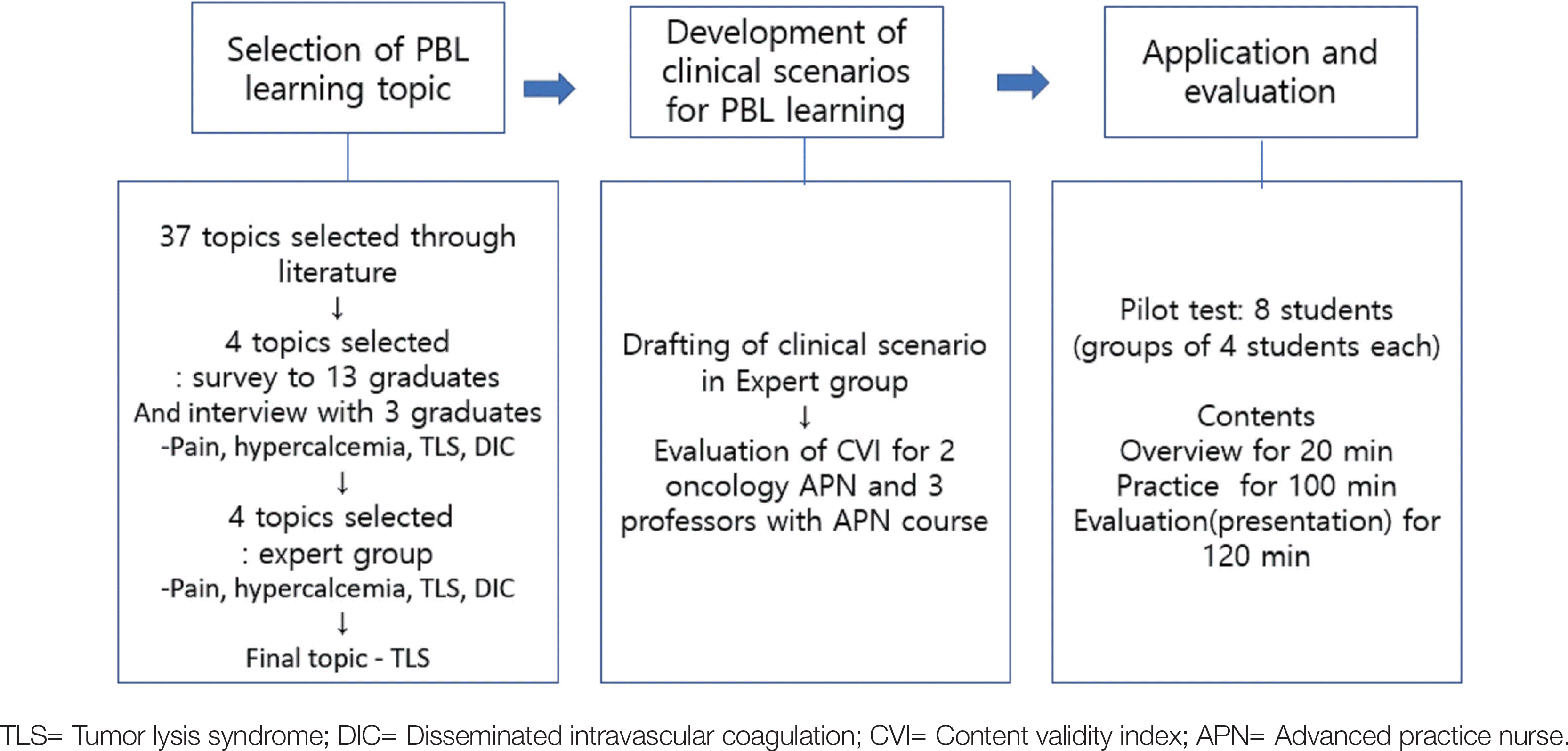초록
Purpose
The purposes of this study were to develop a problem based learning (PBL) module for cancer symptom management and oncology emergencies, and to evaluate the module after applying it for students in an advanced practice nurse program for oncology.
Methods
This study was a methodological research project. We invited a total of 13 graduates from an advanced practice nurse program to evaluate topics for the PBL module development. Five experts developed a PBL module for a selected topic. Eight students from an advanced practice nurse program participated in the PBL learning experience and evaluated their learning experiences.
Results
Tumor lysis syndrome, pain, disseminated intravascular coagulation and hypercalcemia were evaluated to be the most relevant and needed topics for the module. Oncology emergency PBL module-tumor lysis syndrome was developed through expert validation. Evaluation of PBL learning was 3.76 (out of 4 points) in a pilot test.
Go to : 
REFERENCES
1. Kim MY, Choi SJ, Seol M, Kim JH, Kim HY, Byun SJ. The frequency of job performance of the Korean professional medical support staff at medical institutions over 500 beds. J Korean Crit Care Nurs. 2018; 11:15–27.
2. Korean Accreditation Board of Nursing Education (KR). 2017 Korean Advanced Practice Nurse Annual Report. Seoul: Korean Accreditation Board of Nursing Education;2017.
3. Korean Accreditation Board of Nursing (KR). Survey on the qualifying examination for advance practice nurse [Internet]. Available from. http://www.kabon.or.kr/HyAdmin/upload/goodFile/120080306101416.pdf. [Accessed July 20, 2018].
4. Park JS, Park JY, Choi JY. Present condition and future direction of clinical practicum for oncology advanced practice nursing programs. Asian Oncol Nurs. 2015; 15:276–83.

5. Chikotas NE. Theoretical links supporting the use of problem-based learning in the education of the nurse practitioner. Nurs Educ Perspect. 2008; 29:359–62.
6. Servant VF, Schmidt HG. Revisiting ‘Foundations of problem-based learning: some explanatory notes’. Med Educ. 2016; 50:698–701.

7. Joo GE, Sohng KY, Kim HJ. Effects of a standardized patient simulation program for nursing students on nursing competence, communication skill, self-efficacy and critical thinking ability for blood transfusion. Korean Acad Fundam Nurs. 2015; 22:49–58.

8. Hwang SY, Chang KS. The development and implementation of prob-lem-based learning module based on lung cancer case. J Korean Acad Soc Nurs Educ. 2000; 6:390–405.
9. Lee SE. The development and implementation of PBL (Problem based learning) module in maternity nursing based on clinical cases. J Korean Acad Soc Nurs Educ. 2003; 9:81–93.
10. Son YJ, Song YA, Choi EY. Effects of problem-based learning of nursing student. J Korean Acad Fundam Nurs. 2010; 17:82–9.
11. Sayyah M, Shirbandi K, Saki-Malehi A, Rahim F. Use of a problem-based learning teaching model for undergraduate medical and nursing education: a systematic review and metaanalysis. Adv Med Educ Pract. 2017; 8:691–700.
12. Chung IW, Shin CJ, Hahn HS, Song YJ. The Practice and evaluation of problem-based learning in college of medicine, Chungbuk national university. Korean J Med Educ. 1999; 11:285–95.

13. Yarbro CH, Gobel BH, Wujcil D. Cancer symptom management. Burl-ington, MA: Jones & Bartlett Learning. 2013.
14. Yabro CH, Wujcil D, Gobel BH. Cancer nursing-principle and practice. Burlington, MA: Jones & Bartlett Learning. 2016.
15. Moody K, McHugh M, Baker R, Cohen H, Pinto P, Deutsch S, et al. Providing pediatric palliative care education using problem-based learning. J Palliat Med. 2018; 21:22–7.

16. Khatiban M, Falahan SN, Amini R, Farahanchi A, Soltanian A. Lec-ture-based versus problem-based learning in ethics education among nursing students. Nurs Ethics. 2018. In press.
Go to : 
 | undefined TLS= Tumor lysis syndrome; DIC= Disseminated intravascular coagulation; CVI= Content validity index; APN= Advanced practice nurse. |
Table 1.
Selecting Topics for Problem Based Learning for Advanced Practice Nurse for Oncology (N =13)
Table 2.
Problem based Learning Module on Tumor Lysis Syndrome: Tables of Contents
Table 3.
Evaluation of PBL Learning Outcomes (N =8)
검사명 참고치 단위 항암화학요법 당일 2일째




 PDF
PDF ePub
ePub Citation
Citation Print
Print


 XML Download
XML Download